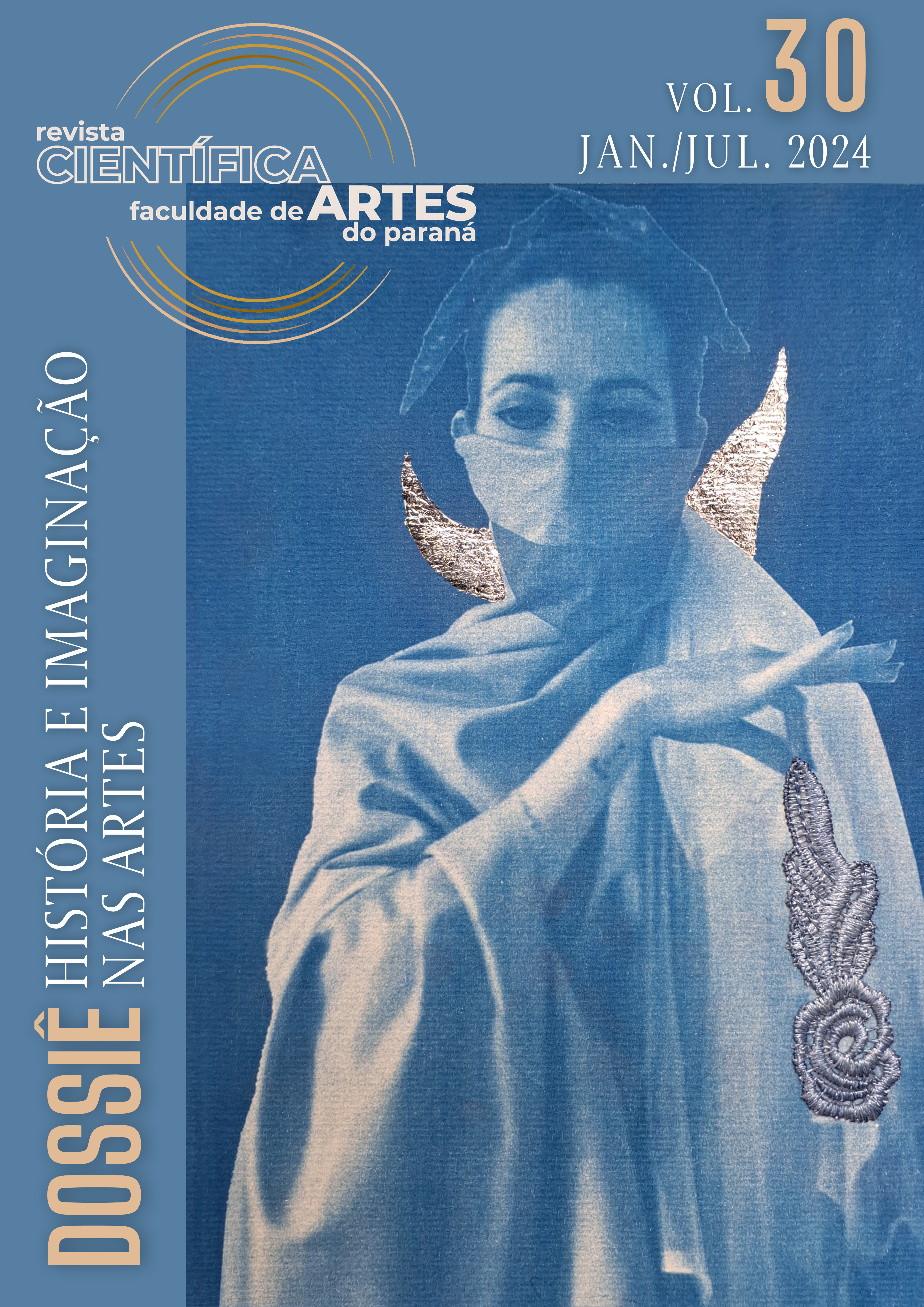A ressignificação do “fenômeno” de caça às bruxas
ecos no filme Rua do Medo: 1666 – Parte 3
DOI:
https://doi.org/10.33871/19805071.2024.30.1.8874Keywords:
caça às bruxas, Cinema, FeminismosAbstract
The “phenomenon” of witch hunting in Western society, which occurred during the 16th to 17th centuries, was brought out of hiding from the second wave of the Feminist Movement in the mid-1970s, and has been debated nowadays under the understanding of an intentional persecution of a group of women who at that time had knowledge about reproduction (midwives), were healers and herbalists, or simply prostitutes and beggars. With this premise, this article aims to historically establish an understanding of why thousands of women were tried, tortured, hanged or burned alive for almost two centuries in Europe and correlate it with the Hollywood horror film Fear Street: 1666 – Part 3, director by Leigh Janiak, and released in 2021 on the Netflix streaming platform. The choice for such a cinematographic narrative is due to the reason of observing the possibility of a new reading of such an event from the point of view of the supposed witch and the beneficiary of such an accusation.
Downloads
References
ALVES, B. Moreira.; PITANGUY, Jacqueline. O que é feminismo. São Paulo: Abril/Cultura, 1981. Coleção Primeiros Passos.
CARDINI, Franco. Magia e Bruxaria na Idade Média e no Renascimento. Psicologia USP,1996, v.7, n.1 2, p. 9-16. Recuperado de: <https://www.revistas.usp.br/psicousp/article/download/34530/37268>.Acesso em: 30 set. 2023.
CLARK, Stuart. Pensando com os demônios. A ideia de bruxaria no princípio da Europa Moderna. Editora da Universidade de São Paulo, 2006, pp. 208-287.
DIAS, Bruno; CABREIRA, Regina Helena. A imagem da bruxa: da antiguidade às representações fílmicas contemporâneas. Ilha do Desterro,Florianópolis, 2019, v.72, n.1, p.175-197. Recuperado de: <https://www.scielo.br/j/ides/a/Q8cJDfsgznTRCpnQdzwc5Jw/?format=pdf&lang=pt>. Acesso em: 14 out. 2023.
FEDERICI, Silvia. Calibã e a bruxa: mulheres, corpo e acumulação primitiva. São Paulo: Ed. Elefante,2017.
LEAL, Ana Christina; VELOSO, Victória; COSTA Clara. Bruxaria e Normalização: a perseguição às mulheres e ao conhecimento tradicional frente à hegemonia do discurso médico. Gênero da Amazônia, Belém, 2019, n.15. Recuperado de: <https://periodicos.ufpa.br/index.php/generoamazonia/article/download/13278/9219>. Acesso em: 20 set. 2023.
JUNIOR,E.B. OLIVEIRA, G.S.; SANTOS, A.C.O; L. SCHNEKENBERG, G.F. Análise documental como percurso metodológico na pesquisa qualitativa. Cadernos da Fucamp, 2021, v.20, n.44, p. 36-51. Recuperado de: <https://revistas.fucamp.edu.br/index.php/cadernos/article/download/2356/1451.> Acesso em: 27 mar. 2023.
MAINKA, Peter. A bruxaria nos tempos modernos – sintoma de crise na transição para a modernidade. Editora UFPR. História: Questões & Debates, Curitiba, 2002, n.37, p. 111-142.
MERCHANT, Carolyn. The death of nature: women, ecology, and the Scientific Revolution. Ed. New York: Harper and Row, 1983, pp. 127 – 172.
RIBEIRO, Paula Regina. MELO, Ailton. Bruxas, Perigosas e desordeiras – A mulher e a culpa na Inquisição. Revista Diversidade e Educação, 2021, v. 9, n. Especial, p. 21-48. Recuperado de: <https://periodicos.furg.br/divedu/article/view/12646/8750>. Acesso em: 27 out. 2023
SILVA, Natália. Burn the witch: a sexualidade feminina como monstruosidade. IN: SÁ, Daniel; MAKENDORF, Marcio. Monstruosidade estética e política. LLE UFSC, Florianópolis, 2019.
SOUZA, Laura de Mello. A feitiçaria na Europa Moderna. São Paulo: Editora Atica, 1987.
VIERA, Elizabeth M. A medicalização do corpo feminino. Rio de Janeiro: Ed. Fiocruz, 2002.
WOLF, Naomi. Vagina – A new biograph. Ecco, 2012.
FILMOGRAFIA:
CARRIE, a estranha. Direção: Brian De Palma. Produção: Brian De Palma, Paul Monash, Louis A. Stroller. Estados Unidos: United Artists, 1976.
PÂNICO. Direção: Wes Craven. Produção: Bob Weinstein, Cathy Konrad, Harvey Weinstein, Nicholas Mastandrea, Cary Woods, Dixie J. Capp, Marianne Maddalena, Stuart M. Besser. Estados Unidos: Dimension Films, 1996.
RUA do medo: 1994 – Parte 1. Direção: Leigh Janiak. Produção: David Ready, Peter Chernin, Leigh Janiak, Jenno Topping. Estados Unidos: Netflix, 2021.
RUA do medo: 1978 – Parte 2. Direção: Leigh Janiak. Produção: David Ready, Peter Chernin, Leigh Janiak, Jenno Topping. Estados Unidos: Netflix, 2021.
RUA do medo: 1666 – Parte 3. Direção: Leigh Janiak. Produção: David Ready, Peter Chernin, Leigh Janiak. Estados Unidos: Netflix, 2021.
SEXTA-FEIRA 13. Direção: Sean S. Cunningham. Produção: Alvin Geiler, Steve Miner, Sean S. Cunningham. Estados Unidos: Paramount Pictures; Warner Bros. Pictures, 1980.
Downloads
Published
How to Cite
Issue
Section
License
The authors retain the copyright, when licensing their production in Revista Científica/FAP, which is licensed under a Creative Commons license. When submitting the article, and upon acceptance, the author assigns his copyright for publication in that journal.
Readers can download, print and use the articles published in the journal, as long as there is always an explicit mention of the author (s) and the Revista Científica/FAP, no changes to the original work are allowed. When submitting an article to Revista Científica/FAP and after its being accepted for publication, the authors allow, without remuneration, to pass the following rights to the Journal: the first edition rights and the authorization for the editorial team to transfer, according to their judgment, this article and its metadata to indexing and reference services.


